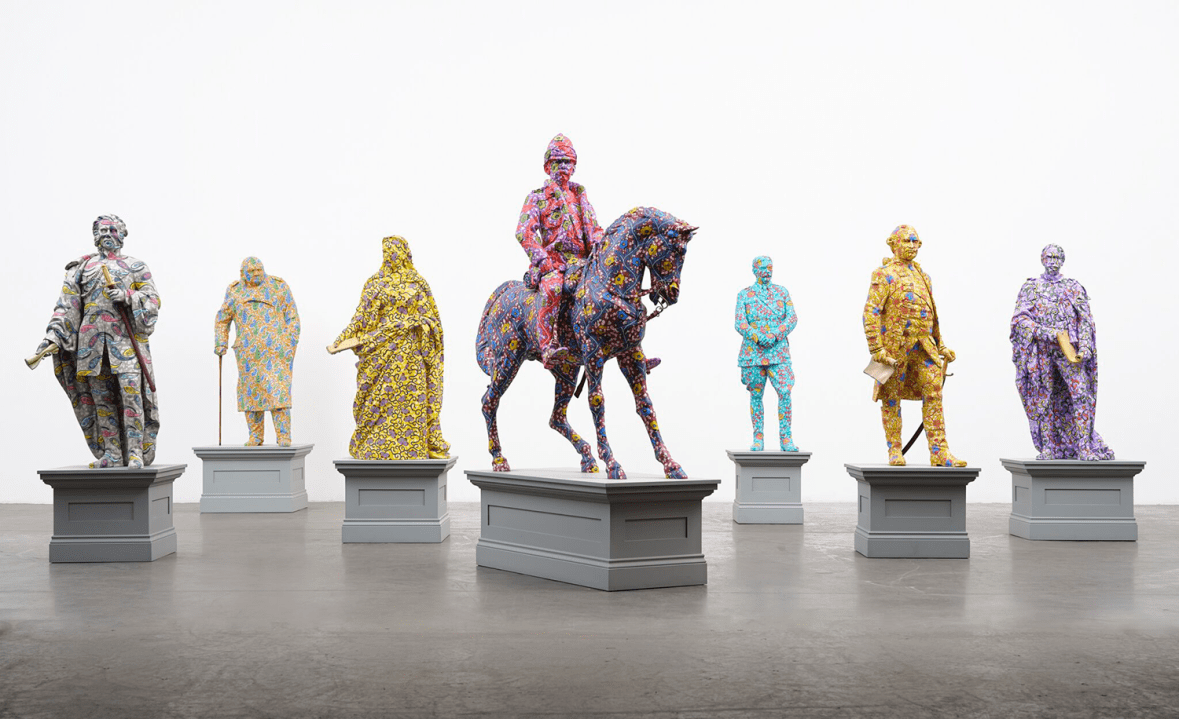More than seven centuries ago, the medieval cartographer Richard of Haldingham created Hereford Cathedral’s Mappa Mundi; I say ‘created’ because when he drew his map it was largely a work of the imagination. Its terra incognita is populated with bizarre creatures born of the fever dreams of early travel writers: his Africa is inhabited by Monocules, one-eyed, one-legged men who use their single foot as a parasol, and his Asia is roamed by the Bonnacon, a bull-like creature with inward-curling horns whose only defence is his projectile faeces.
As a Londoner who grew up in Lagos he felt kinship with the hybrid creatures of the Mappa Mundi
Five years ago, when Yinka Shonibare was invited by Hereford Cathedral to design a series of quilts featuring ‘Creatures of the Mappa Mundi’, he told me that as a native Londoner who grew up in Lagos he felt a certain kinship with the hybrid nature of these creatures of the medieval imagination. And there is something beguiling about the defecating Bonnacon appliquéd like a heraldic beast to the colourful quilt in his exhibition at the Serpentine. Like everything else, the quilt features scraps of the ‘African’ batik cloth that has become the artist’s signature.
Since his discovery as a student at Goldsmiths that the wax-printed cloth synonymous with Africa was never, in fact, African at all (it was manufactured in Holland to Indonesian designs for export to British colonies – it’s now made in China) he has used it as a metaphor for the hybridity of our globalised world. It can be glimpsed in the background of his 2023 ‘African Bird Magic’ quilts featuring endangered species and in the illuminated interiors of the miniature models of places of refuge in his new ‘Sanctuary City’ (2024) installation. His ‘Wind Sculpture in Bronze’ (2024), blown in from the park like an autumn leaf, is covered in its brightly coloured patterns, as are – more controversially – his ‘Decolonised Structures’ (2022), fibreglass copies of colonial era monuments to figures from Queen Victoria to Churchill.
The artist, who wears his CBE with pride, is not in favour of tipping public statuary in the drink: the patterning is not a graffiti protest, it’s a way of highlighting monuments most of us walk past without thinking. Shonibare worries that our memories are short and need jogging, which is what his series of ‘Libraries’ is for. His latest, ‘The War Library’ (2024), lines the walls of the show’s last room with thousands of batik-bound volumes with embossed gold titles recording centuries of alternating conflicts and peace treaties. They’re not in alphabetical or chronological order – ‘The Cooking Pot Uprising’ is squeezed between ‘The Treaty of Abo’ and ‘The War of 1905’ – and you can’t take the volumes down to read. ‘It’s an archive of human failure, if you like,’ he admits, yet the books’ vibrant bindings flood the space with colour. ‘I wish the world could actually be as beautiful as the work of the artist,’ he told the assembled press at the preview. Don’t we all.
Magdalene Odundo has also been thinking about war: the Jasperware pièce de résistance of her new show in the 18th-century State Rooms of Houghton Hall, made during a residency with Wedgwood, is titled ‘the falcon cannot hear the falconer’ after Yeats’s 1919 poem ‘The Second Coming’. Created as a centrepiece for a table in the Marble Parlour, its wedding cake-like tiers are decorated with silhouettes of colonial-era slave restraints, scenes of recent tax riots in her native Kenya and portrait medallions of Josiah Wedgwood and his fellow abolitionist Olaudah Equiano, topped by a triumphant black female figure. ‘If it’s confrontational, it’s intentional; if it’s calm, it’s also intentional,’ she explains gnomically.
It’s atypical of an artist known for her abstract ceramic vessels, but like Shonibare, Odundo is happy to be hybrid. Trained in English art schools, she’s a British studio potter by education and a global ceramicist by absorption. Her black-and-orange vessels are coaxed into shape with a hand-building technique acquired in Abuja, finished with a terra sigillata slip more ancient than the Greeks and fired according to the Mexican Pueblo method to achieve a level of burnish that rivals the patina of the bronze Laocoön in William Kent’s Stone Hall.
There has always been an anthropomorphic element to the language of pots with their shoulders, necks, lips, jug ears and pot bellies, and Odundo’s added nubs suggesting tummy buttons or nipples are clear references to the human body. The two tall vessels with little ear handles in the hall’s empty alcoves recall Kenyan memorials to the spirits of the dead; a third has joined the ancestral portraits in the Saloon. Other associations are more playful: a jaunty flask beckons to a Sèvres sauce boat in the Common Parlour, while a bashful pot with a swan-neck and a gaping mouth flirts with a porcelain crane in the Green Velvet Bedchamber. ‘I wanted to have the setting as a dramatic stage,’ says Odundo. Amazingly, her multicultural mise-en-scène works.








Comments